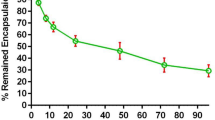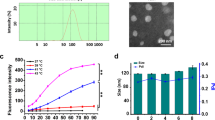Abstract
Liposomes are a useful means of delivering molecular targeting agents such as small interfering RNA (siRNA) to downregulate specific pathways important in cancer growth and progression. The ability to non-invasively image these carriers is important to ascertain their delivery within the tumor. As cyclooxygenase-2 (COX-2) is an important therapeutic target in cancer, we investigated loading COX-2-specific siRNA into cationic liposomes containing MR contrast agents for imaging delivery in cancer cells and tumors. COX-2 and GAPDH siRNA, as well as Magnevist or Feridex, were loaded directly into the liposomes. These lipoplexes were used for cell transfection of the poorly differentiated and highly metastatic breast cancer cell line MDA-MB-231. PEGylated liposomes loaded with Feridex and fluorescently labeled COX-2 siRNA were used for in vivo delivery of lipoplexes in MDA-MB-231 breast cancer xenografts in female SCID mice. Transient transfection assays demonstrated potent and specific downregulation of the COX-2 protein in cells in culture. Tail vein injections of PEGylated COX-2 lipoplexes resulted in intratumoral delivery of siRNA. Biodistribution studies showed significant localization in the lung, liver and kidney at 24 h. These data demonstrate the feasibility of liposomal-mediated delivery of COX-2-specific siRNA to downregulate COX-2 in cancer cells, and multi-modality imaging of the delivery of specific siRNA in tumors.
This is a preview of subscription content, access via your institution
Access options
Subscribe to this journal
Receive 12 print issues and online access
$259.00 per year
only $21.58 per issue
Buy this article
- Purchase on Springer Link
- Instant access to full article PDF
Prices may be subject to local taxes which are calculated during checkout







Similar content being viewed by others

References
Wang D, DuBois RN . Inflammatory mediators and nuclear receptor signaling in colorectal cancer. Cell Cycle 2007; 6: 682–685.
De Marzo AM, Platz EA, Sutcliffe S, Xu J, Grönberg H, Drake CG et al. Inflammation in prostate carcinogenesis. Nat Rev Cancer 2007; 7: 256–269.
Diaz-Cruz ES, Brueggemeier RW . Interrelationships between cyclooxygenases and aromatase: unraveling the relevance of cyclooxygenase inhibitors in breast cancer. Anticancer Agents Med Chem 2006; 6: 221–232.
Stasinopoulos I, O’Brien DR, Wildes F, Glunde K, Bhujwalla ZM . Silencing of cyclooxygenase-2 inhibits metastasis and delays tumor onset of poorly differentiated metastatic breast cancer cells. Mol Cancer Res 2007; 5: 435–442.
Lasic DD . Colloid chemistry. Liposomes within liposomes. Nature 1997; 387: 26–27.
Zelphati O, Szoka Jr FC . Intracellular distribution and mechanism of delivery of oligonucleotides mediated by cationic lipids. Pharm Res 1996; 13: 1367–1372.
Xu L, Huang CC, Huang W, Tang WH, Rait A, Yin YZ et al. Systemic tumor-targeted gene delivery by anti-transferrin receptor scFv-immunoliposomes. Mol Cancer Ther 2002; 1: 337–346.
Sioud M, Sorensen DR . Systemic delivery of synthetic siRNAs. Methods Mol Biol 2004; 252: 515–522.
Cardoso AL, Simoes S, de Almeida LP, Pelisek J, Culmsee C, Wagner E et al. siRNA delivery by a transferrin-associated lipid-based vector: a non-viral strategy to mediate gene silencing. J Gene Med 2007; 9: 170–183.
Foged C, Nielsen HM, Frokjaer S . Liposomes for phospholipase A2 triggered siRNA release: preparation and in vitro test. Int J Pharm 2007; 331: 160–166.
Xia H, Mao Q, Paulson HL, Davidson BL . siRNA-mediated gene silencing in vitro and in vivo. Nat Biotechnol 2002; 20: 1006–1010.
Ulrich AS . Biophysical aspects of using liposomes as delivery vehicles. Biosci Rep 2002; 22: 129–150.
Sioud M, Sorensen DR . Cationic liposome-mediated delivery of siRNAs in adult mice. Biochem Biophys Res Commun 2003; 312: 1220–1225.
Sorensen DR, Leirdal M, Sioud M . Gene silencing by systemic delivery of synthetic siRNAs in adult mice. J Mol Biol 2003; 327: 761–766.
Pirollo KF, Zon G, Rait A, Zhou Q, Yu W, Hogrefe R et al. Tumor-targeting nanoimmunoliposome complex for short interfering RNA delivery. Hum Gene Ther 2006; 17: 117–124.
Pirollo KF, Rait A, Zhou Q, Hwang SH, Dagata JA, Zon G et al. Materializing the potential of small interfering RNA via a tumor-targeting nanodelivery system. Cancer Res 2007; 67: 2938–2943.
Hogrefe RI, Lebedev AV, Zon G, Pirollo KF, Rait A, Zhou Q et al. Chemically modified short interfering hybrids (siHYBRIDS): nanoimmunoliposome delivery in vitro and in vivo for RNAi of HER-2. Nucleosides Nucleotides Nucleic Acids 2006; 25: 889–907.
Sato A, Takagi M, Shimamoto A, Kawakami S, Hashida M . Small interfering RNA delivery to the liver by intravenous administration of galactosylated cationic liposomes in mice. Biomaterials 2007; 28: 1434–1442.
Yano J, Hirabayashi K, Nakagawa S, Yamaguchi T, Nogawa M, Kashimori I et al. Antitumor activity of small interfering RNA/cationic liposome complex in mouse models of cancer. Clin Cancer Res 2004; 10: 7721–7726.
Bisanz K, Yu J, Edlund M, Spohn B, Hung MC, Chung LW et al. Targeting ECM–integrin interaction with liposome-encapsulated small interfering RNAs inhibits the growth of human prostate cancer in a bone xenograft imaging model. Mol Ther 2005; 12: 634–643.
Medarova Z, Pham W, Farrar C, Petkova V, Moore A . In vivo imaging of siRNA delivery and silencing in tumors. Nat Med 2007; 13: 372–377.
Cailleau R, Young R, Olive M, Reeves Jr WJ . Breast tumor cell lines from pleural effusions. J Natl Cancer Inst 1974; 53: 661–674.
Dass CR, Walker TL, Burton MA . Liposomes containing cationic dimethyl dioctadecyl ammonium bromide: formulation, quality control, and lipofection efficiency. Drug Deliv 2002; 9: 11–18.
Fesus L, Thomazy V, Falus A . Induction and activation of tissue transglutaminase during programmed cell death. FEBS Lett 1987; 224: 104–108.
Grosch S, Maier TJ, Schiffmann S, Geisslinger G . Cyclooxygenase-2 (COX-2)-independent anticarcinogenic effects of selective COX-2 inhibitors. J Natl Cancer Inst 2006; 98: 736–747.
Li SD, Huang L . Targeted delivery of antisense oligodeoxynucleotide and small interference RNA into lung cancer cells. Mol Pharm 2006; 3: 579–588.
Santel A, Aleku M, Keil O, Endruschat J, Esche V, Fisch G et al. A novel siRNA-lipoplex technology for RNA interference in the mouse vascular endothelium. Gene Therapy 2006; 13: 1222–1234.
Yu W, Pirollo KF, Rait A, Yu B, Xiang LM, Huang WQ et al. A sterically stabilized immunolipoplex for systemic administration of a therapeutic gene. Gene Therapy 2004; 11: 1434–1440.
Frank JA, Zywicke H, Jordan EK, Mitchell J, Lewis BK, Miller B et al. Magnetic intracellular labeling of mammalian cells by combining (FDA-approved) superparamagnetic iron oxide MR contrast agents and commonly used transfection agents. Acad Radiol 2002; 9 (Suppl. 2): S484–S487.
Matsumura Y, Maeda H . A new concept for macromolecular therapeutics in cancer chemotherapy: mechanism of tumoritropic accumulation of proteins and the antitumor agent smancs. Cancer Res 1986; 46 (12 Part 1): 6387–6392.
Litzinger DC, Brown JM, Wala I, Kaufman SA, Van GY, Farrell CL et al. Fate of cationic liposomes and their complex with oligonucleotide in vivo. Biochim Biophys Acta 1996; 1281: 139–149.
Zelphati O, Uyechi LS, Barron LG, Szoka Jr FC . Effect of serum components on the physico-chemical properties of cationic lipid/oligonucleotide complexes and on their interactions with cells. Biochim Biophys Acta 1998; 1390: 119–133.
Acknowledgements
This study was supported by NIH grants 2R01 CA 82337, NIH P50 CA103175, NIH U54 CA091409 (in collaboration with Dr Paul Wang at Howard University) and DOD-COE W81XWH-04-1-0595. We thank Drs Jan Hoh and Paul Wang for valuable scientific discussion, Mr Reza Hosseini for technical assistance and Mr Gary Cromwell for technical assistance with the animal studies.
Author information
Authors and Affiliations
Corresponding author
Additional information
Supplementary Information accompanies the paper on Cancer Gene Therapy website (http://www.nature.com/cgt)
Rights and permissions
About this article
Cite this article
Mikhaylova, M., Stasinopoulos, I., Kato, Y. et al. Imaging of cationic multifunctional liposome-mediated delivery of COX-2 siRNA. Cancer Gene Ther 16, 217–226 (2009). https://doi.org/10.1038/cgt.2008.79
Received:
Revised:
Accepted:
Published:
Issue Date:
DOI: https://doi.org/10.1038/cgt.2008.79
Keywords
This article is cited by
-
Fundamentals of siRNA and miRNA therapeutics and a review of targeted nanoparticle delivery systems in breast cancer
Biophysical Reviews (2018)
-
Differential bioreactivity of neutral, cationic and anionic polystyrene nanoparticles with cells from the human alveolar compartment: robust response of alveolar type 1 epithelial cells
Particle and Fibre Toxicology (2015)
-
Magnetic Nanoparticles for Cancer Diagnosis and Therapy
Pharmaceutical Research (2012)


